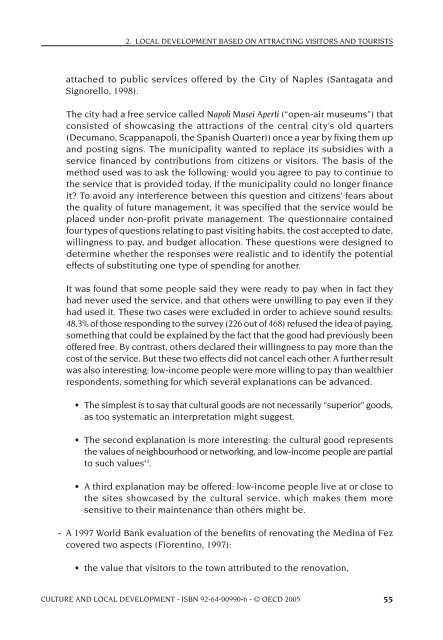OECD Culture and Local Development.pdf - PACA
OECD Culture and Local Development.pdf - PACA
OECD Culture and Local Development.pdf - PACA
You also want an ePaper? Increase the reach of your titles
YUMPU automatically turns print PDFs into web optimized ePapers that Google loves.
2. LOCAL DEVELOPMENT BASED ON ATTRACTING VISITORS AND TOURISTS<br />
attached to public services offered by the City of Naples (Santagata <strong>and</strong><br />
Signorello, 1998).<br />
The city had a free service called Napoli Musei Aperti (“open-air museums”) that<br />
consisted of showcasing the attractions of the central city’s old quarters<br />
(Decumano, Scappanapoli, the Spanish Quarter)) once a year by fixing them up<br />
<strong>and</strong> posting signs. The municipality wanted to replace its subsidies with a<br />
service financed by contributions from citizens or visitors. The basis of the<br />
method used was to ask the following: would you agree to pay to continue to<br />
the service that is provided today, if the municipality could no longer finance<br />
it? To avoid any interference between this question <strong>and</strong> citizens’ fears about<br />
the quality of future management, it was specified that the service would be<br />
placed under non-profit private management. The questionnaire contained<br />
four types of questions relating to past visiting habits, the cost accepted to date,<br />
willingness to pay, <strong>and</strong> budget allocation. These questions were designed to<br />
determine whether the responses were realistic <strong>and</strong> to identify the potential<br />
effects of substituting one type of spending for another.<br />
It was found that some people said they were ready to pay when in fact they<br />
had never used the service, <strong>and</strong> that others were unwilling to pay even if they<br />
had used it. These two cases were excluded in order to achieve sound results:<br />
48.3% of those responding to the survey (226 out of 468) refused the idea of paying,<br />
something that could be explained by the fact that the good had previously been<br />
offered free. By contrast, others declared their willingness to pay more than the<br />
cost of the service. But these two effects did not cancel each other. A further result<br />
was also interesting: low-income people were more willing to pay than wealthier<br />
respondents, something for which several explanations can be advanced.<br />
• The simplest is to say that cultural goods are not necessarily “superior” goods,<br />
as too systematic an interpretation might suggest.<br />
• The second explanation is more interesting: the cultural good represents<br />
the values of neighbourhood or networking, <strong>and</strong> low-income people are partial<br />
to such values 42 .<br />
• A third explanation may be offered: low-income people live at or close to<br />
the sites showcased by the cultural service, which makes them more<br />
sensitive to their maintenance than others might be.<br />
- A 1997 World Bank evaluation of the benefits of renovating the Medina of Fez<br />
covered two aspects (Fiorentino, 1997):<br />
• the value that visitors to the town attributed to the renovation,<br />
CULTURE AND LOCAL DEVELOPMENT - ISBN 92-64-00990-6 - © <strong>OECD</strong> 2005 55














